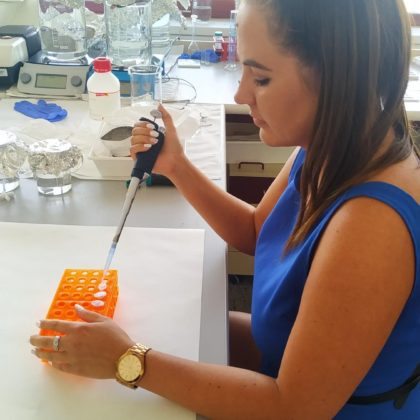Ludmila is going to Italy…
…to test bioconjugated nanocarriers directly on cancer cells. “I hope we will take the research another step further,” she says.
Ludmila Žárská, PhD. student of medical biophysics, is another of the Nano4Tarmed´s “pilot” researchers. This project led by doc. Vaclav Ranc aims to design and implement active-drug-delivery nanocarriers targeting directly the cancer tissue. In fall, Ludmila will join the partner´s team in Italian ISTEC—Institute of Science and Technology for Ceramics to study the effect of active drugs on the cells.
Ludmila´s work has been focused in past months on development and modification of the properties of nanocarriers, specifically graphene-oxide flakes. Their size and stability are crucial for effective application. “Active substance conjugated to the carrier has to stay in a given chemical bond until it reaches its goal—cancer tissue, where it gets released. For its successful penetration of cell walls, we have to optimize its size. Simultaneously, we want to reach the highest possible concentration of the substance on the carrier surface. Its size is now around 100–150 nanometres. Another problematic to investigate is a process of biochemical reactions among the active substance, carrier and cancer tissue. We are working on all these topics now,” explains Ludmila.
“In this phase, I will bring with me to the Italian laboratories nanoplatforms that have been already bioconjugated to the functional molecular drugs. There, we will test their effect directly on cancer cells. I´m looking forward to finally working with the 3D cell structures,” says Ludmila.
“We will focus mainly on cytotoxicity—a capacity of an active drug to destroy the cancer cells followed by an optimization of its concentration for different types of tumor. What works in one case doesn’t have to work elsewhere. It is a complex process which I hope we will take another step further,” concludes Ludmila.
Besides the project related research, Ludmila has her PhD. studies to finish and is getting ready to defend her dissertation thesis dedicated to photodynamic therapy and testing of the photosensitisers—light sensitive substances—in cancer cells. This type of treatment uses different properties of normal and tumor cells and their reactivity to photosensitizers which help through a light medium to destroy the damaged cells.


